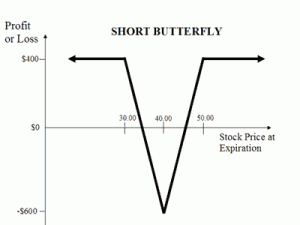The short put butterfly is very similar to the long put butterfly. One difference is that a short put butterfly is bullish on volatility. It is a limited profit, limited risk options strategy. There are usually three striking prices involved in a short put butterfly. A short put butterfly can be constructed by writing one lower striking out-of-the-money put, buying two at-the-money puts and writing another higher striking in-the-money put, giving the options trader a net credit to put on the trade.
LIMITED PROFIT
When the underlying stock price rally pass the higher strike price or drops below the lower strike price at expiration, maximum profit is attained for the short put butterfly.
If the stock ends up at the higher striking price, all the put options expire worthless and the short put butterfly trader keeps the initial credit taken when entering the trade.
If, instead, the stock price at expiry is equal to the lower strike price, the lower striking put option expires worthless while the profits of the remaining long put is canceled out by the loss incurred from shorting the higher strike put. So the maximum profit is still only the initial credit taken.
The formula for calculating maximum profit is given below:
- Max Profit = Net Premium Received – Commissions Paid
- Max Profit Achieved When Price of Underlying <= Strike Price of Lower Strike Short Put OR Price of Underlying >= Strike Price of Higher Strike Short Put
Limited Risk
When the price of the underlying asset remains unchanged at expiration, maximum loss for the short put butterfly is incurred. At this price, only the higher striking put which was shorted expires in-the-money. The trader will have to buy back that put option at its intrinsic value to exit the trade.
The formula for calculating maximum loss is given below:
- Max Loss = Strike Price of Higher Strike Short Put – Strike Price of Long Put – Net Premium Received + Commissions Paid
- Max Loss Occurs When Price of Underlying = Strike Price of Long Put
